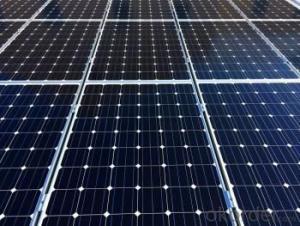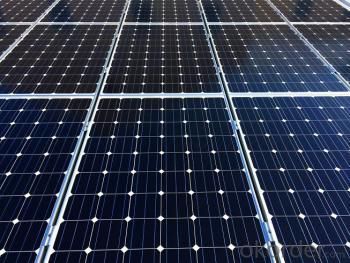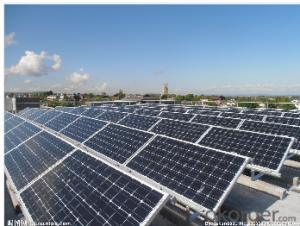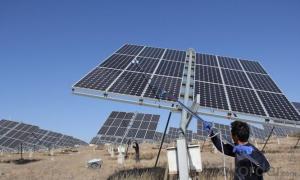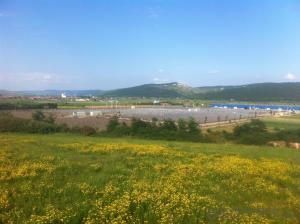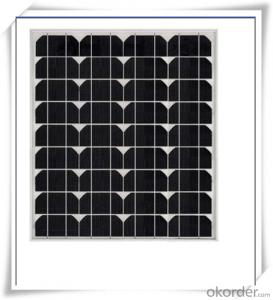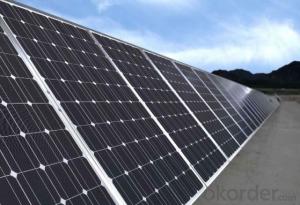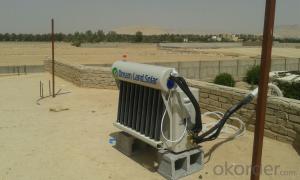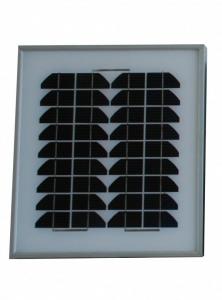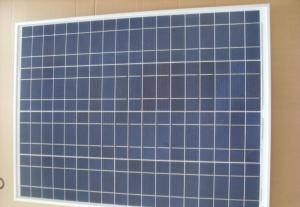Dasol Solar Panels 150 Medium Monocrystalline Solar Panel CNBM
- Loading Port:
- Qingdao
- Payment Terms:
- TT OR LC
- Min Order Qty:
- 10 set
- Supply Capability:
- 300000 set/month
OKorder Service Pledge
OKorder Financial Service
You Might Also Like
Monocrystalline Solar Panel with 110W
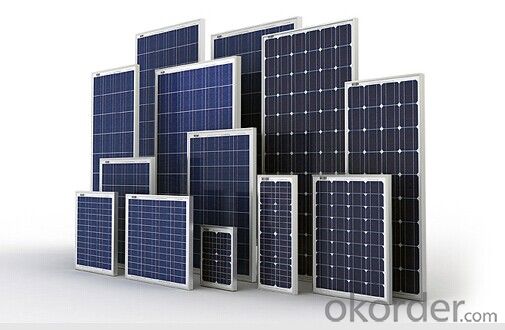
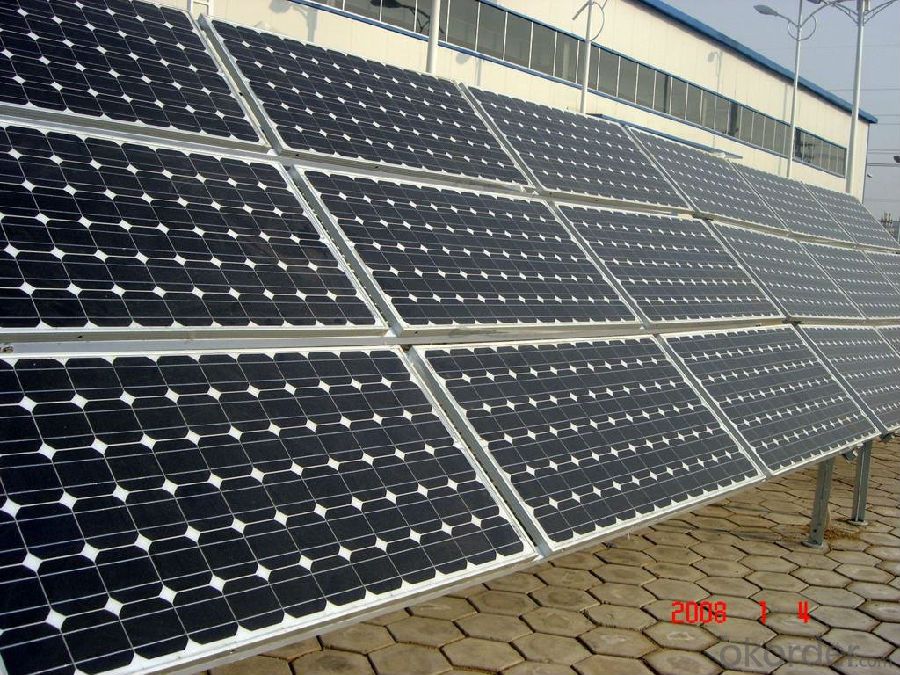
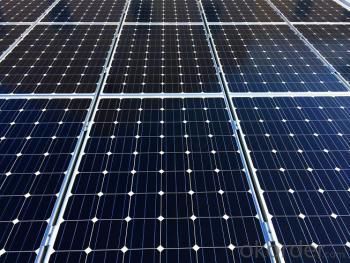
Monocrystalline Solar Modules
We offers a range of small, medium and large monocrystalline solar modules, designed for a range of requirements.
Specifications:
Tolerance | +/- 3% |
Cell | Monocrystalline silicon solar cells |
N0. of Cells | 72 (12 x 6) |
Dimension of Modules (mm) | 1581 x 809 x 40 |
Weight (kg) | 15.5 |
Limits:
Operating Temperature | -40~+85? |
Storage Temperature | -40~+85? |
Maximum System Voltage | 1000 VDC max. |
Hail Impact | Diameter of 28mm with impact speed of 86km/h |
Temperature and Coefficients:
NOCT | 48C+/-2? |
Voltage temperature coefficient (%/K) | -0.34 |
Current temperature coefficient (%/K) | 0.09 |
Power temperature coefficient (%/K) | -0.37 |
Characteristics:
Model: | SGM-160D | SGM-165D | SGM-170D |
Max-power voltage Vmp (V) | 34.5 | 35.4 | 35.8 |
Max-power current Imp (A) | 4.64 | 4.66 | 4.75 |
Open-circuit voltage Voc (V) | 41.75 | 43.6 | 43.32 |
Short-Circuit Current Isc (A) | 5.32 | 5.08 | 5.38 |
Max-power Pm(W) | 160 | 165 | 170 |
Model: | SGM-175D | SGM-180D | SGM-185D |
Max-power voltage Vmp (V) | 36.1 | 36.2 | 36.2 |
Max-power current Imp (A) | 4.85 | 4.97 | 5.11 |
Open-circuit voltage Voc (V) | 43.68 | 43.8 | 44.8 |
Short-Circuit Current Isc (A) | 5.49 | 5.48 | 5.51 |
Max-power Pm(W) | 175 | 180 | 185 |
STC: Irradiance 1000W/m2, Module temperature 25?, AM=1.5
Monocrystalline Solar Panels Specifications Range
Maximum Power (Pm) | Dimension | Weight | Operating Voltage (Vmp) | Operating Current (Imp) | Open Circuit Voltage (Voc) | Short Circuit Current (Isc) |
3W | 158x241x25mm | 0.5kg | 8.5V | 0.36A | 10.5V | 0.4A |
4W | 308x166x25mm | 0.77kg | 8.5V | 0.47A | 10.5V | 0.54A |
4W | 308.x166x25mm | 0.77kg | 16.8V | 0.24A | 21V | 0.27A |
5W | 296x215x25mm | 0.3kg | 16.8V | 0.48a | 21V | 0.54A |
10W | 286x406x25mm | 1.5kg | 16.8V | 0.59A | 21V | 0.66A |
12W | 286x406x25mm | 1.5kg | 16.8V | 0.71A | 21V | 0.8A |
14W | 286x541x25mm | 2kg | 16.8V | 0.83A | 21V | 0.96A |
16W | 286x541x25mm | 2kg | 17.2V | 0.93A | 21.5V | 0.99A |
18W | 296x541x25mm | 2.4kg | 18.8V | 1.07A | 21V | 1.2A |
20W | 296x641x25mm | 2.4kg | 17.2V | 1.15A | 21.5V | 1.24A |
24W | 541x451x25mm | 3.15kg | 16.8V | 1.14A | 21V | 1.56A |
26W | 541x451x25mm | 3.15kg | 17.2V | 1.51A | 21.5V | 1.63A |
30W | 296x966x25mm | 3.85kg | 16.8V | 1.78A | 21V | 2.03A |
36W | 541x641x35mm | 4.7kg | 16.8V | 2.14a | 21V | 2.4A |
40W | 541x641x35mm | 4.7kg | 17.2V | 2.33A | 21.5V | 2.5A |
55W | 1057x457x35mm | 6.6kg | 17.6V | 3.12A | 21.6V | 3.3A |
70W | 546x1196x35mm | 8.5kg | 16.8V | 4.15A | 21V | 4.7A |
75W | 546x1196x35mm | 8.5kg | 17.2V | 4.36A | 21.5V | 4.8A |
80W | 546x1196x35mm | 8.5kg | 17.6V | 4.55A | 21.6V | 4.9A |
110W | 1066x811x40mm | 11.8kg | 17.6V | 6.25A | 21.6V | 6.6A |
150W | 1066x811x40mm | 14kg | 34.4V | 4.36A | 43.2V | 4.7A |
- Q: I have 2 solar panels one is 5 watts 2 volts .2 amps or -The other is 50 watts 2 volts 2.6 amps or-Can I ...and what is the best way to hook them togeather to increase my amps being put back to my battery ?? I would be hooking them up to a 7 amp 00 watt charge controllerThe panels are rated 2 volt but the specs say they will produce more whennot connected to charge controllerPlease advise and should I even bother with the smaller panel ?
- The answer is that the two panels should be put in parallel. The voltage out will drop to the voltage of the lower panel, but you should get most of the power, if the panels aren't too badly mismatched. I would try to get a multimeter and try to measure the actual current coming out of the panels in full sun. Sometimes the specifications on these smaller panels are very optimistic. If the whole setup is putting out less than 2 amps, I'd say wire the whole thing straight to the battery - little chance of boiling the electrolyte at those currents.
- Q: How do solar panels affect the property's green certification?
- Solar panels can have a positive impact on a property's green certification. By generating clean and renewable energy, solar panels contribute to reducing the property's carbon footprint. This aligns with the criteria for green certification, which typically includes factors such as energy efficiency and sustainability. Installing solar panels can enhance a property's overall sustainability profile, making it more likely to meet the requirements for green certification.
- Q: Hi, I am starting to get curious about the pros/cons of installing solar panels - has anyone done it and is it worth it?
- In the state of Pennsylvania in the USA, a very basic 5KW solar installation will cost you $35,000. Of that you will recover approximately $28,000 over the next five (5) years between the State and the Feds. Making your net-cost something between $7,000 and $9,000 depending on various factors. All other things being equal in a standard household with fuel-based heat and window units vs. central AC, this system will provide roughly 50% of power required with a payback of approximately eight (8) years (with electricity at $0.4/kwh). The system has an estimated forty (40) year service life. Without _all_ the subsidies, the payback is longer than the estimated system life, especially if you consider the time-value of money. The life-cycle cost of a photo-voltaic array is horrendous. By that, I mean the total cost of producing the panels, installing them, and then removing them and disposing of them in an environmentally correct manner. All that added in and there is a negative payback. So, it all depends on what one defines as worth it. Putting the cost onto taxpayers via governmental subsidy to make an otherwise wretchedly expensive process viable may give you all sorts of warm-and-fuzzy feelings about renewable resources and reducing dependence on foreign oil and so forth. But the reality is that the true cost of solar panels exceeds that of nuclear power per KW delivered. Even today when nuclear plants start in the Billions-with-a-B in any currency you would care to name.
- Q: Alright my family and i are buying a new home in Bradford,Ontario, we we thinking about solar panels and had a couple questions:. how much are they each?2. how many will we need to power a single family home(4 ppl)3. where can we find them in ontario?4.how much money do they really save you?5.what kind of energy do they providfe you withand other basic info or a website i can check out would be great!thanks in advance!
- Just think about it and don't do it unless Ontario and the Utility companies give a huge rebate. Forget tax credits. Solar voltaic panels generate electricity...it will take more than 20 years to break even...assuming they last that long. Solar panels that generate hot water may be OK but will take about 0 years for a payback.
- Q: Can solar panels be used in areas with high levels of shade?
- Solar panels can still be used in areas with high levels of shade, but their efficiency and energy production may be significantly reduced.
- Q: Thinking about getting a solar panel installed but i'm worried about getting the govt. rebates. There is a Federal Tax credit and a State of Florida rebate and i'm wondering what the time frame is for getting the rebates. Has anyone gotten a solar panel installed recently that could give me more info.Thanks!
- In case you hadn't heard the state is broke.
- Q: How do solar panels withstand harsh weather conditions?
- Solar panels are designed to withstand harsh weather conditions through their durable construction and protective features. They are made with materials like tempered glass, which is resistant to hail and impact damage. Additionally, they are built to be waterproof and sealed to prevent moisture penetration. Solar panels also undergo rigorous testing to ensure they can withstand extreme temperatures, strong winds, and snow loads. These measures enable solar panels to endure various weather conditions and continue generating clean energy efficiently.
- Q: Can solar panels be used in remote areas without access to the grid?
- Yes, solar panels can be used in remote areas without access to the grid. Solar panels generate electricity by capturing sunlight and converting it into usable energy. This renewable energy source is particularly useful in off-grid locations as it provides a sustainable and independent power supply. With advancements in solar technology and the availability of battery storage systems, solar panels can effectively meet the energy needs of remote areas, even during nighttime or periods of low sunlight. This makes solar panels an ideal solution for powering homes, businesses, and infrastructure in remote locations without grid connectivity.
- Q: Around this time here in Georgia we will begin to get some big storms with high winds. I have a solar panel on a mount that isn't all that sturdy and could be knocked over with any winds pretty much above 5mph. I can't put anything in the ground to do this. I used to have it mounted to the roof of a playground for the most sunlight, but because of the angle of the sun and the tree leaves, I have to have it on a quot;portablemount so I can move it throughout the day, and I can tell you one thing is certain, and that's that it isn't the most sturdy thing ever. I'll have it a little better next weekend but it'll still be able to easily blow in the wind. Should I just hang the panel along the wall during a storm then reconnect it to its base once it's over?I'm pretty good with wood, so any wood creations to help out with the thing would greatly help. Just please keep it on a low budget.
- Solar panels are a costly and significant investment. Therefore, protecting them from harm should be a top priority. Unfortunately, moisture and water are common ways for solar panels to become damaged or broken. Safekeeping solar panels from both of these threats is a simple, inexpensive procedure, and doing so might save the solar panel owner a bundle if carried out correctly Instructions : Set a thick strip of silicone between each cell when putting the solar panel together, in order to prevent moisture seepage. 2: Use Plexiglas instead of glass as the face of your solar panel. Plexiglas is less liable to break and therefore safe from hailstorms or accidents. 3: Glue adhesive silicone to each side of your solar panel(s), adding additional sealant and protection from water to your commodity. :)
- Q: Can solar panels be installed on educational institutions?
- Yes, solar panels can be installed on educational institutions. In fact, many schools and universities are increasingly adopting solar power systems to reduce their carbon footprint, lower energy costs, and provide educational opportunities for students to learn about renewable energy sources. Installing solar panels on educational institutions can help promote sustainability and inspire a greener future among students and the wider community.
Send your message to us
Dasol Solar Panels 150 Medium Monocrystalline Solar Panel CNBM
- Loading Port:
- Qingdao
- Payment Terms:
- TT OR LC
- Min Order Qty:
- 10 set
- Supply Capability:
- 300000 set/month
OKorder Service Pledge
OKorder Financial Service
Similar products
Hot products
Hot Searches
Related keywords
